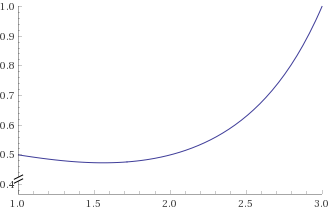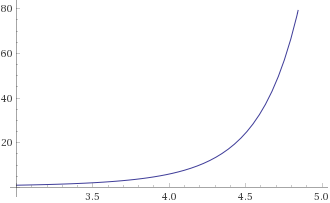Did I find out something in my dreams? (I)
One day, I was asleep, and in my dream yesterday, I dreamt that I was playing with factorials. I then got this sudden revelation of a weird formula:
\(\LARGE{\frac{1! × 2! × ... × n!}{1 × 2 × ... × 2n}}\)
Simplifying this, we can get:
Where is the and is the superfactorial
When we substitute with different values, we gain these numbers:
I decided to plot this using WolframAlpha, but I do not have the Pro Version, so I plotted a smaller range of values instead (because I was bored a lot...)






Does this graph or number set have any special value to them? I was just bored, but maybe you can find a better explanation for these numbers. I would love to see what random facts you can gain about these weird numbers that came to me in a dream...
Easy Math Editor
This discussion board is a place to discuss our Daily Challenges and the math and science related to those challenges. Explanations are more than just a solution — they should explain the steps and thinking strategies that you used to obtain the solution. Comments should further the discussion of math and science.
When posting on Brilliant:
*italics*or_italics_**bold**or__bold__paragraph 1
paragraph 2
[example link](https://brilliant.org)> This is a quote# I indented these lines # 4 spaces, and now they show # up as a code block. print "hello world"\(...\)or\[...\]to ensure proper formatting.2 \times 32^{34}a_{i-1}\frac{2}{3}\sqrt{2}\sum_{i=1}^3\sin \theta\boxed{123}Comments
@Vinayak Srivastava, @Mahdi Raza, @Yajat Shamji, @Páll Márton
Do these numbers look like something similar, like any other number?
Please give in a small research and let me know...
Log in to reply
@Hamza Anushath, Wait! I got it! I know what's special about these numbers! I figured it out!
They all are.....
Reply to this comment to know the answer.
Log in to reply
The answer is.....
Decimal numbers (Irrational I think, but could be rational)
Wow! This is my 2nd biggest discovery after I discovered that 1+1 = 2!
LOL, XD!!! LOL, XD!!! LOL, XD!!! LOL, XD!!!
Log in to reply
Yes @Yashvardhan Pattanashetti
Plus, they are rational numbers, as they repeat their digits forever
Log in to reply
awesome
Maybe you should have written:
Log in to reply
Nice one, @Vinayak Srivastava!
LOL!! nice!!
Maybe replace the Fermat with @Yashvardhan Pattanashetti's name?
What do you think?
Log in to reply
I'd rather have it be Fermat
Log in to reply
Ok, then. But good joke, no?
Log in to reply
Yup! It was awesome!!
Log in to reply
Ok, then.
I guessed you made a discovery in my dreams. I was still awake around 10:30 when I suddenly thought about new problem series:
Hexadecimal clocks
Binary clocks
Algebraic binary locks
Algebraic hexadecimal locks
Basically, I am a walking-talking mathematician as well. @Hamza Anushath, @Yashvardhan Pattanashetti, @Páll Márton
Log in to reply
Woah, are you a walking... talking... mathematician!?!
I am just a minor mathematician...
Log in to reply
In my sleep, I am talking about being a walking-talking mathematician.
Do you think I am a walking-talking mathematician?
Log in to reply
Yes
Log in to reply
Ok.
Not the zombie type of walking-talking, though.
Log in to reply
We get that. lol
Log in to reply
Ok. But what do you think?
Do you think I am a walking-talking mathematician?
Log in to reply
Talking-yes, walking, i havent seen you walk, mathematician yes
Log in to reply
Ok, then.
What do you think about my new problem series that I mentioned?
Log in to reply
I think its a great idea!!
Just thought of two more problem series:
Hexadecimal locks
Binary locks
What do you think, @Yashvardhan Pattanashetti?
Log in to reply
Nice!! Looking forward to it.
Log in to reply
Posting the first hexadecimal lock problem in 5 mins.
Log in to reply
Ok, good luck
Log in to reply
Wait - change that to binary locks - hexadecimal locks will never work.
Posting it...
... now
The only thing I was able to link this to was the superfactorial, defined by Neil Sloane and Simon Plouffe to be the product of incrementing factorials (the numerator in your expression). Using the notation for a superfactorial, your expression could simplify to:
(2n)!sf(n)
Log in to reply
Thanks a lot @David Stiff! If you could, could you tell me whether the graph I generated is correct or not...?
Log in to reply
You're welcome Hamza!
I wrote some Python code to generate a graph of this expression, and both the numerical values and the graph are identical to those you calculated. I only used the superfactorial form however, not the more general Barnes G-function. I don't think I can post pictures in a reply, but here are the first 10 values I got:
1,0.5,0.083,0.016,0.007142857142857143,0.009523809523809525,0.05194805194805195,1.4385614385614385,241.67832167832168
I find it interesting that the graph first descends, bottoms out at n=4 and then ascends again, rocketing up at n=6.
Log in to reply
Thanks a lot once again @David Stiff
P.S. We can post pictures in a comment by uploading it in a note and copying that code and pasting it here, the code starting with ![]
Log in to reply
No problem. And thanks for the tip!
You can't generate a graph using this function, @David Stiff, @Hamza Anushath
I was just thinking, I could simplify your top equation:
2n!n!!
Try it, @Hamza Anushath
n!! is the double factorial. @Hamza Anushath
Log in to reply
@Yajat Shamji, it's not the double Factorial, it is actually a superfactorial...
Log in to reply
Oops. But did you try it?
Log in to reply
Yes, and very sorry, it brought a wrong value @Yajat Shamji
Log in to reply
Well, at least you tried.